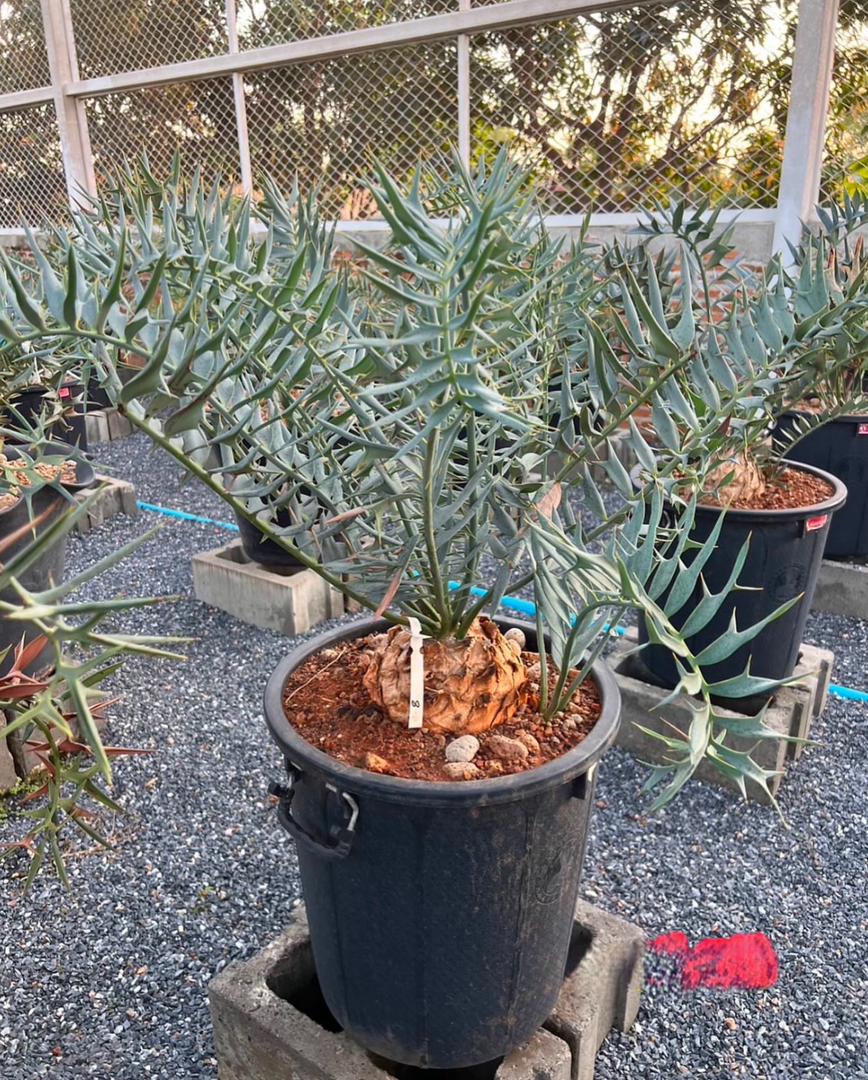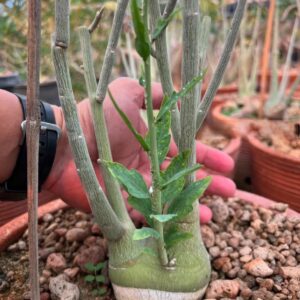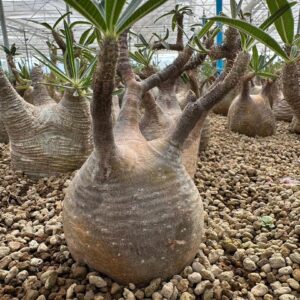Encephalartos horridus
Encephalartos horridus, also known as the Eastern Cape blue cycad, is a small, low-growing cycad native to the Eastern Cape Province of South Africa. The species name horridus comes from the Latin word for ‘bristly,’ describing the plant’s stiff, spiny leaflets.
-
Typically, Encephalartos horridus grows up to 0.9 meters (3 feet) in height and width. Mature plants have stems ranging from 0.5 to 1 meter (20-39 inches) in length and 20-30 cm (8-12 inches) in diameter, with most of the stem growing underground. Many stems may be present.
-
The leaves, up to 1 meter (39 inches) long, are a notable blue-gray color, though the intensity of the color may vary. Younger leaves exhibit a silvery-blue hue that transitions to green as they age. The stiff, sharply pointed leaflets often curve and twist, contributing to the plant’s formidable appearance.
-
Encephalartos horridus produces both male and female cones, typically brownish- or blackish-red with a dense layer of fine hair. The egg-shaped female cones can reach up to 40 cm (15.5 inches) long and 20 cm (8 inches) in diameter, while the largely cylindrical male cones narrow towards the ends, growing up to 40 cm (16 inches) long and 12 cm (4.5 inches) in diameter.
-
The seeds are roughly triangular with three flattened surfaces1. They are oblong, with a pale red or carmine sarcotesta, about 3.5-5 cm long and 2-5 cm in diameter, slightly angled by compression, with a fleshy beak.
Encephalartos horridus is endemic to a small region of the Eastern Cape province of South Africa, within the Albany Thicket biome. This area has hot, dry summers and cool, wet winters, which the cycad is adapted to. It favors dry, rocky slopes and hillsides with well-drained soils, often growing in exposed positions among drought-tolerant vegetation. It occurs from 100 to 400 meters above sea level.
-
The plant requires full sun.
-
Encephalartos horridus may form living fences to keep livestock at bay because of its toughened foliage that is stiff and well armed with spines.
-
The species reproduces by forming cones. Male cones tend to be more tubular and thin, while female cones are thicker8.
-
It is slow-growing and can live for centuries.
Encephalartos horridus is currently assessed as Endangered. Its limited distribution makes it particularly vulnerable to habitat loss and other threats
How can I grow Encephalartos horridus in a home garden
To successfully grow Encephalartos horridus in your home garden, follow these guidelines:
-
Provide full sun exposure for at least 6 hours daily to promote optimal growth and enhance the blue color of the leaves.
-
Use a well-draining loamy soil. A mix designed for cacti and succulents can be beneficial, ensuring that the soil does not retain too much moisture, which can lead to root rot.
-
Water sparingly, allowing the soil to dry out almost completely between waterings. This plant is drought-tolerant and prefers dry conditions over excessive moisture.
-
Ideal growing temperatures are around 25°C (77°F). It can tolerate light to moderate frost but thrives in subtropical climates. Maintain humidity levels around 50%.
-
Apply a balanced fertilizer with an N-P-K ratio of 10-10-10 during the growing season (typically every 4-6 weeks) to support healthy growth.
-
Be aware that Encephalartos horridus has a dormancy period during cooler months, so adjust watering and care accordingly during this time.
-
Propagation can be done through seeds or offsets. For beginners, purchasing a seedling from a nursery is recommended as it is easier than growing from seed or suckers.
-
Repot every 2-3 years or when the plant outgrows its current container. Choose a pot that is slightly larger and ensure it has good drainage.
-
Monitor for pests such as curculionid weevils, which can threaten the plant in its native habitat. Regular checks can help manage any infestations early.
By following these care instructions, you can cultivate Encephalartos horridus successfully in your garden or as a potted plant indoors.
What are the best soil conditions for Encephalartos horridus
For Encephalartos horridus, the best soil conditions include:
-
This is crucial to prevent root rot. A mix of sandy soil, pumice, and perlite can create an ideal growing medium for proper drainage and aeration.
-
This type of soil is preferred.
-
Encephalartos horridus prospers in soil with this pH.
-
This type of soil is beneficial for the plant.
-
Many growers use pure pumice, sometimes adding about twenty-five percent good oak mulch or similar biotic soil to the pumice
What are the ideal temperature ranges for Encephalartos horridus
The ideal temperature range for Encephalartos horridus is as follows:
-
: The plant thrives best in temperatures between 21°C to 32°C (70°F to 90°F) for optimal growth and health.
-
: Encephalartos horridus can tolerate lower temperatures down to 10°C (50°F) for short periods, but prolonged exposure to such conditions can be detrimental.
-
: While it can handle light frosts, heavy frost can be fatal, so it’s important to protect the plant from freezing temperatures.
Maintaining these temperature conditions will help ensure the healthy growth of Encephalartos horridus.
How can I use greenhouses to manage the temperature for Encephalartos horridus
Using a greenhouse can be an effective way to manage the temperature for Encephalartos horridus, helping to maintain optimal growing conditions. Here’s how:
: Most cycads, including Encephalartos horridus, thrive in temperatures between 21°C to 32°C (70°F to 90°F). A greenhouse helps maintain this range, which is crucial for their metabolic processes, growth, and overall health.
: Use thermometers and monitoring tools to keep an eye on temperature fluctuations within the greenhouse.
: Position the greenhouse in an area that provides natural protection from extreme temperatures.
: Employ heaters to maintain a warm microclimate during cold spells and cooling systems, such as evaporative coolers, to reduce heat during hotter months.
: Use ventilation and shading structures to control airflow and reduce excess heat, protecting plants from sudden temperature spikes. Ensure adequate air circulation to prevent disease.
:
: As temperatures rise, focus on adapting the greenhouse to prevent overheating. Proper air circulation and maintaining optimal soil pH can help mitigate pathogens that thrive in heat.
: Greenhouses help maintain warmer temperatures compared to the outside, though heating may still be required to reach optimal levels.
:
: Greenhouses utilize advanced construction techniques and materials that allow for maximum sunlight penetration while protecting plants from environmental stressors3.
: Watering plants with cold water can slightly cool the soil and overall greenhouse environment8.
By using these strategies, you can create a stable environment within the greenhouse that supports the Encephalartos horridus‘s life cycle, conserves energy, and minimizes costs





Reviews
There are no reviews yet.